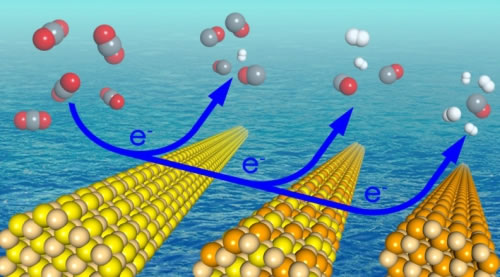
Sulfur selenide cadmium alloy nanorods electroreduction carbon dioxide production syngas diagram
Recently, Professor Zeng Jie's group at the Hefei National Institute for Physical Sciences at the Microscale Research Institute and the School of Chemistry and Materials Science at the University of Science and Technology of China has used a cadmium selenide cadmium alloy nanorod with adjustable composition as a catalyst to efficiently reduce carbon dioxide to syngas. The catalyst of the cadmium selenide cadmium alloy nanorod exhibits high activity and high stability in the carbon dioxide electroreduction reaction and can regulate the composition ratio of the synthesis gas over a wide range.
Syngas, the mixture of carbon monoxide and hydrogen, is an important synthetic raw material in petrochemicals. In different chemical processes, the optimal compositional ratio of the synthesis gas needed is correspondingly different. The traditional methods for preparing synthesis gas include the gasification of coal and the reforming of natural gas, both of which require the consumption of non-renewable energy. The use of carbon dioxide and water as raw materials for the electroreduction of carbon dioxide in aqueous solutions is an ideal method for the sustainable production of synthesis gas. However, current catalysts for the electroreduction of carbon dioxide are difficult to control syngas over a wide range while ensuring high current densities. Composition ratio.
Based on this, researchers used liquid-phase synthesis technology to design and synthesize cadmium selenide cadmium alloy nanorods catalysts with adjustable composition. The researchers found that the higher the selenium content in the catalyst, the more intermediate the hydrogen in the reaction and the higher the proportion of hydrogen components in the synthesis gas product. Studies have shown that at an overpotential of -1.2V, the ratio of carbon monoxide to hydrogen in the product synthesis gas can be freely adjusted between 4:1 and 1:4. At the same time, no matter what proportion of the synthesis gas, the current density exceeds 25mA/cm-2. In the 10-hour stability test using the catalyst continuously, the current density remained basically stable, and the composition ratio of the product synthesis gas also remained basically unchanged.
Relevant research results were published in the "Advanced Materials". He Sheng, a doctoral student, and Zhang An, a postgraduate student, were the co-first authors. The study was supported by the Frontier Science Key Research Project of the Chinese Academy of Sciences, the National Major Scientific Research Plan, the National Natural Science Foundation, and the Ministry of Education.
Tabletop Poster Stand,Poster Display Stand,Outdoor Poster Stand,Poster Holder Stand
MGX Metalworks Co., Ltd. , https://www.mgxmetal.com